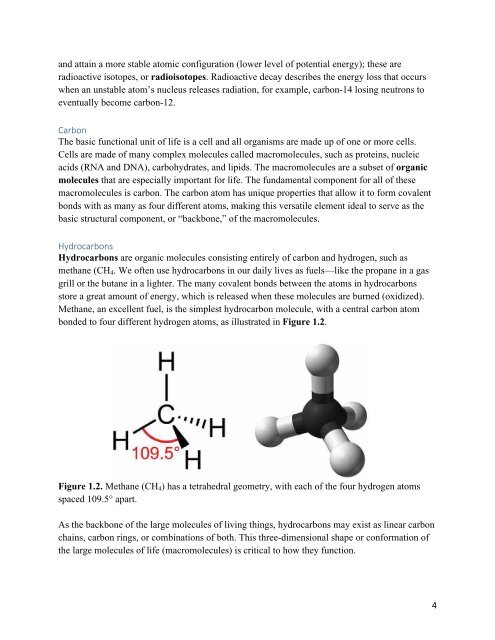Introduction to Environmental Science, 2nd Edition, 2018a
Introduction to Environmental Science, 2nd Edition, 2018a
Introduction to Environmental Science, 2nd Edition, 2018a
You also want an ePaper? Increase the reach of your titles
YUMPU automatically turns print PDFs into web optimized ePapers that Google loves.
and attain a more stable a<strong>to</strong>mic configuration (lower level of potential energy); these are<br />
radioactive iso<strong>to</strong>pes, or radioiso<strong>to</strong>pes. Radioactive decay describes the energy loss that occurs<br />
when an unstable a<strong>to</strong>m’s nucleus releases radiation, for example, carbon-14 losing neutrons <strong>to</strong><br />
eventually become carbon-12.<br />
<br />
The basic functional unit of life is a cell and all organisms are made up of one or more cells.<br />
Cells are made of many complex molecules called macromolecules, such as proteins, nucleic<br />
acids (RNA and DNA), carbohydrates, and lipids. The macromolecules are a subset of organic<br />
molecules that are especially important for life. The fundamental component for all of these<br />
macromolecules is carbon. The carbon a<strong>to</strong>m has unique properties that allow it <strong>to</strong> form covalent<br />
bonds with as many as four different a<strong>to</strong>ms, making this versatile element ideal <strong>to</strong> serve as the<br />
basic structural component, or “backbone,” of the macromolecules.<br />
<br />
Hydrocarbons are organic molecules consisting entirely of carbon and hydrogen, such as<br />
methane (CH 4 . We often use hydrocarbons in our daily lives as fuels—like the propane in a gas<br />
grill or the butane in a lighter. The many covalent bonds between the a<strong>to</strong>ms in hydrocarbons<br />
s<strong>to</strong>re a great amount of energy, which is released when these molecules are burned (oxidized).<br />
Methane, an excellent fuel, is the simplest hydrocarbon molecule, with a central carbon a<strong>to</strong>m<br />
bonded <strong>to</strong> four different hydrogen a<strong>to</strong>ms, as illustrated in Figure 1.2.<br />
Figure 1.2. Methane (CH 4 ) has a tetrahedral geometry, with each of the four hydrogen a<strong>to</strong>ms<br />
spaced 109.5° apart.<br />
As the backbone of the large molecules of living things, hydrocarbons may exist as linear carbon<br />
chains, carbon rings, or combinations of both. This three-dimensional shape or conformation of<br />
the large molecules of life (macromolecules) is critical <strong>to</strong> how they function.


















